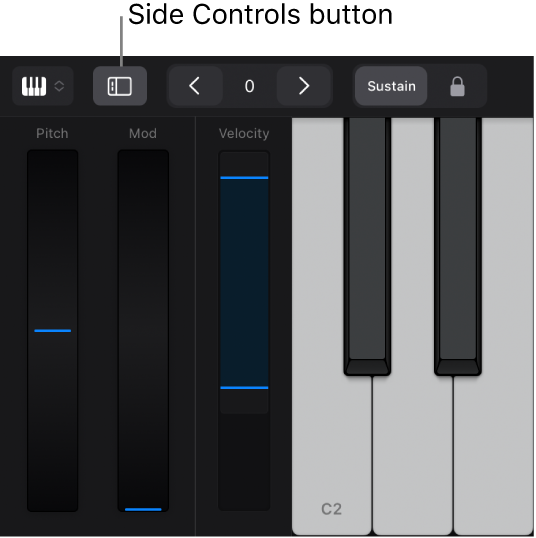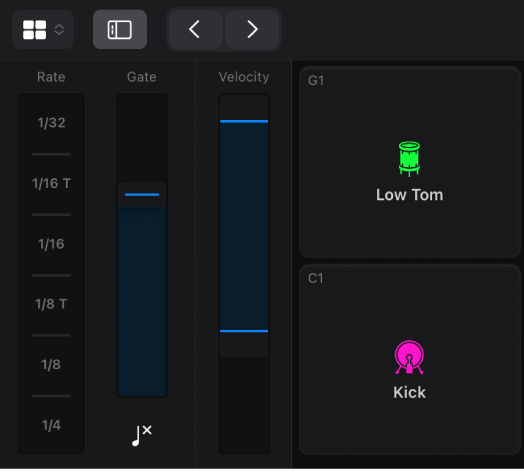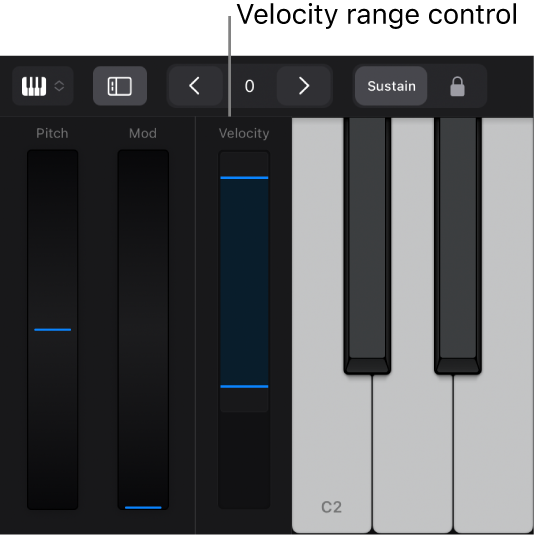Logic Pro User Guide for iPad
- What’s new in Logic Pro 1.1
-
- What is Logic Pro?
- Working areas
- Work with function buttons
- Work with numeric values
-
- Intro to tracks
- Create tracks
- Create tracks using drag and drop
- Choose the default region type for a software instrument track
- Select tracks
- Duplicate tracks
- Reorder tracks
- Rename tracks
- Change track icons
- Change track colors
- Use the tuner on an audio track
- Show the output track in the Tracks area
- Delete tracks
- Edit track parameters
- Start a Logic Pro subscription
- How to get help
-
- Intro to recording
-
- Before recording software instruments
- Record software instruments
- Record additional software instrument takes
- Record to multiple software instrument tracks
- Record multiple MIDI devices to multiple tracks
- Record software instruments and audio simultaneously
- Merge software instrument recordings
- Spot erase software instrument recordings
- Replace software instrument recordings
- Capture your most recent MIDI performance
- Use the metronome
- Use the count-in
-
- Intro to arranging
-
- Intro to regions
- Select regions
- Cut, copy, and paste regions
- Move regions
- Remove gaps between regions
- Delay region playback
- Trim regions
- Loop regions
- Repeat regions
- Mute regions
- Split and join regions
- Stretch regions
- Separate a MIDI region by note pitch
- Bounce regions in place
- Change the gain of audio regions
- Create regions in the Tracks area
- Convert a MIDI region to a Drummer region or a pattern region
- Rename regions
- Change the color of regions
- Delete regions
- Create fades on audio regions
- Access mixing functions using the Fader
-
- Intro to Step Sequencer
- Use Step Sequencer with Drum Machine Designer
- Record Step Sequencer patterns live
- Step record Step Sequencer patterns
- Load and save patterns
- Modify pattern playback
- Edit steps
- Edit rows
- Edit Step Sequencer pattern, row, and step settings in the inspector
- Customize Step Sequencer
-
- Effect plug-ins overview
-
- Instrument plug-ins overview
-
- ES2 overview
- Interface overview
-
- Modulation overview
-
- Vector Envelope overview
- Use Vector Envelope points
- Use Vector Envelope solo and sustain points
- Set Vector Envelope segment times
- Vector Envelope XY pad controls
- Vector Envelope Actions menu
- Vector Envelope loop controls
- Vector Envelope release phase behavior
- Vector Envelope point transition shapes
- Use Vector Envelope time scaling
- Use the Mod Pad
- Modulation source reference
- Via modulation source reference
-
- Sample Alchemy overview
- Interface overview
- Add source material
- Save a preset
- Edit mode
- Play modes
- Source overview
- Synthesis modes
- Granular controls
- Additive effects
- Additive effect controls
- Spectral effect
- Spectral effect controls
- Filter module
- Low and highpass filter
- Comb PM filter
- Downsampler filter
- FM filter
- Envelope generators
- Mod Matrix
- Modulation routing
- Motion mode
- Trim mode
- More menu
- Sampler
- Copyright
Use side controls with the Play Surfaces in Logic Pro for iPad
The side controls consist of pitchbend, modulation, note repeat, and velocity range. You can use these to change the character of the sound when using a Play Surface. The controls for pitchbend and modulation and those for note repeat are mutually exclusive, so turning on one set of controls turns off the other. When you open the side controls, they appear on the left side of the Play Surface.

Turn on the side controls
In the Play Surface menu bar, tap the Side Controls button
 .
.The side controls appear to the left of the Play Surface. By default, the pitch and modulation controls are active and the velocity range control is visible.
Use note repeat in the side controls
In the Play Surface menu bar, tap the More button
 , tap View Options, then tap Note Repeat.
, tap View Options, then tap Note Repeat.Controls for note repeat appear to the left of the Play Surface.

Touch a bar/beat value in the Rate slider to set the repeat rate.
Play notes in the Play Surface.
Drag the Gate slider up or down to set the length of the repeated note.
Change the values for the note repeat controls
In the Play Surface menu bar, tap the More button
 , then tap Configuration.
, then tap Configuration.Under Note Repeat, do the following:
Change the gate range: Tap the Gate Range fields and set the Low or High values.
Change the note repeat values: Tap a value for the corresponding slot and choose a bar/beat value.
Use the mod wheel to send MIDI expression control change
In the Play Surface menu bar, tap the More button
 , tap Configuration, then tap Expression (CC# 11) in the Mod Wheel pop-up menu.
, tap Configuration, then tap Expression (CC# 11) in the Mod Wheel pop-up menu.
Change the velocity mode
The velocity mode determines how the velocity values for MIDI notes are created. You can set the velocity to a fixed value or set it to be determined by how hard you tap the Play Surface. The velocity for drum pads can also be determined by the vertical tap position on the drum pad.
In the Play Surface menu bar, tap the More button
 , tap Surface Settings, then choose one of the following values for Velocity Mode:
, tap Surface Settings, then choose one of the following values for Velocity Mode:Fixed: Forces all notes to the same velocity set by the velocity value.
Dynamic: The velocity value is determined by how hard you tap the drum pads. Minimum and maximum velocity are determined by the Velocity Range values.
Y-Position: The velocity value is determined by the vertical tap position on the drum pad. Minimum and maximum velocity are determined by the Velocity Range values.
You can use the Velocity controller in the Play Surface to change the velocity range or the fixed velocity value.
Change the velocity range
Depending on the velocity mode setting, you can change velocity range or set a fixed velocity value.
In the Play Surface menu bar, tap the More button
 , tap View Options, then tap Velocity.
, tap View Options, then tap Velocity.Tap the Side Controls button
 .
.The velocity range control appears to the left of the Play Surface.

If the velocity mode is set to Dynamic or Y-Position, do one of the following:
Drag the top slider of the velocity range control up to change the maximum velocity value.
Drag the bottom slider of the velocity range control down to change the minimum velocity value.
Touch the velocity range control between the sliders and drag up or down to move the velocity range.
If the velocity mode is set to Fixed, drag the velocity slider up or down to set the velocity value.
Download this guide: PDF